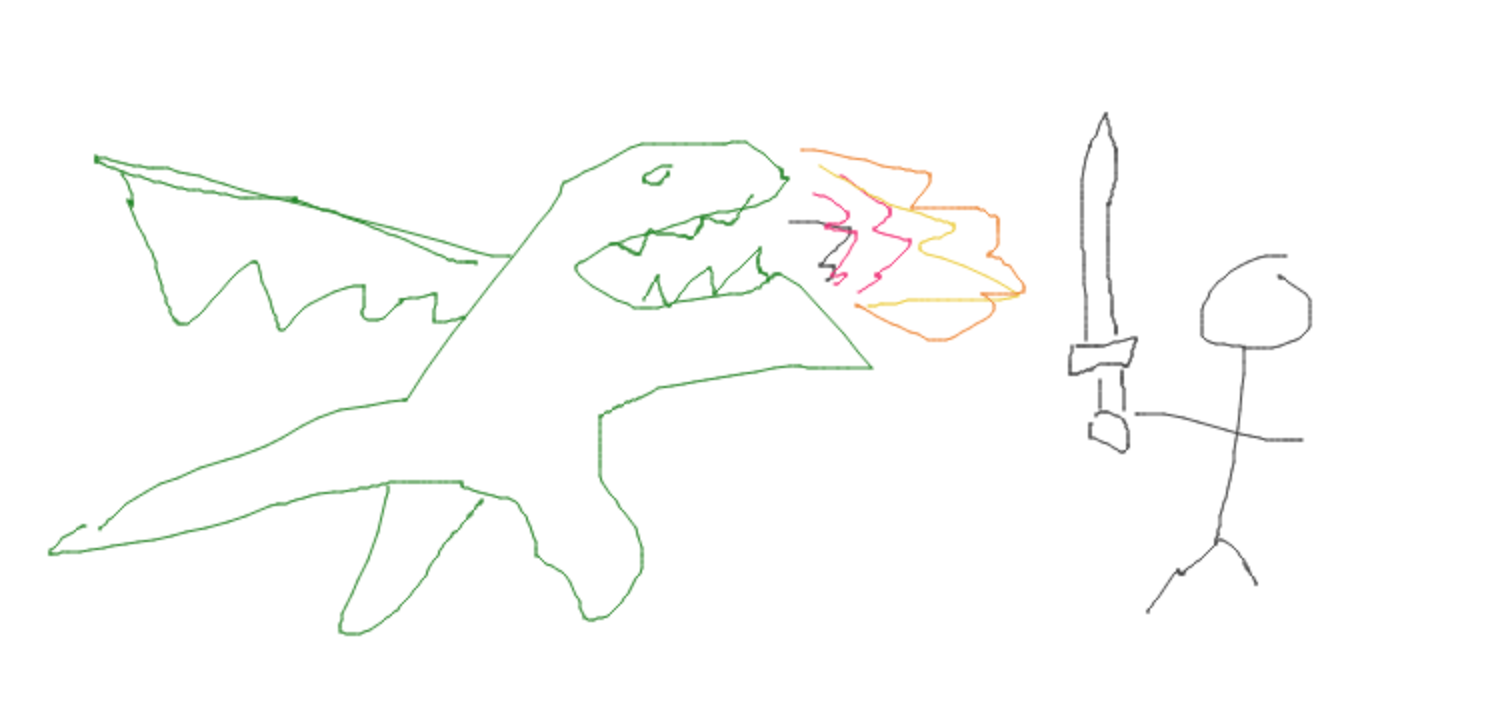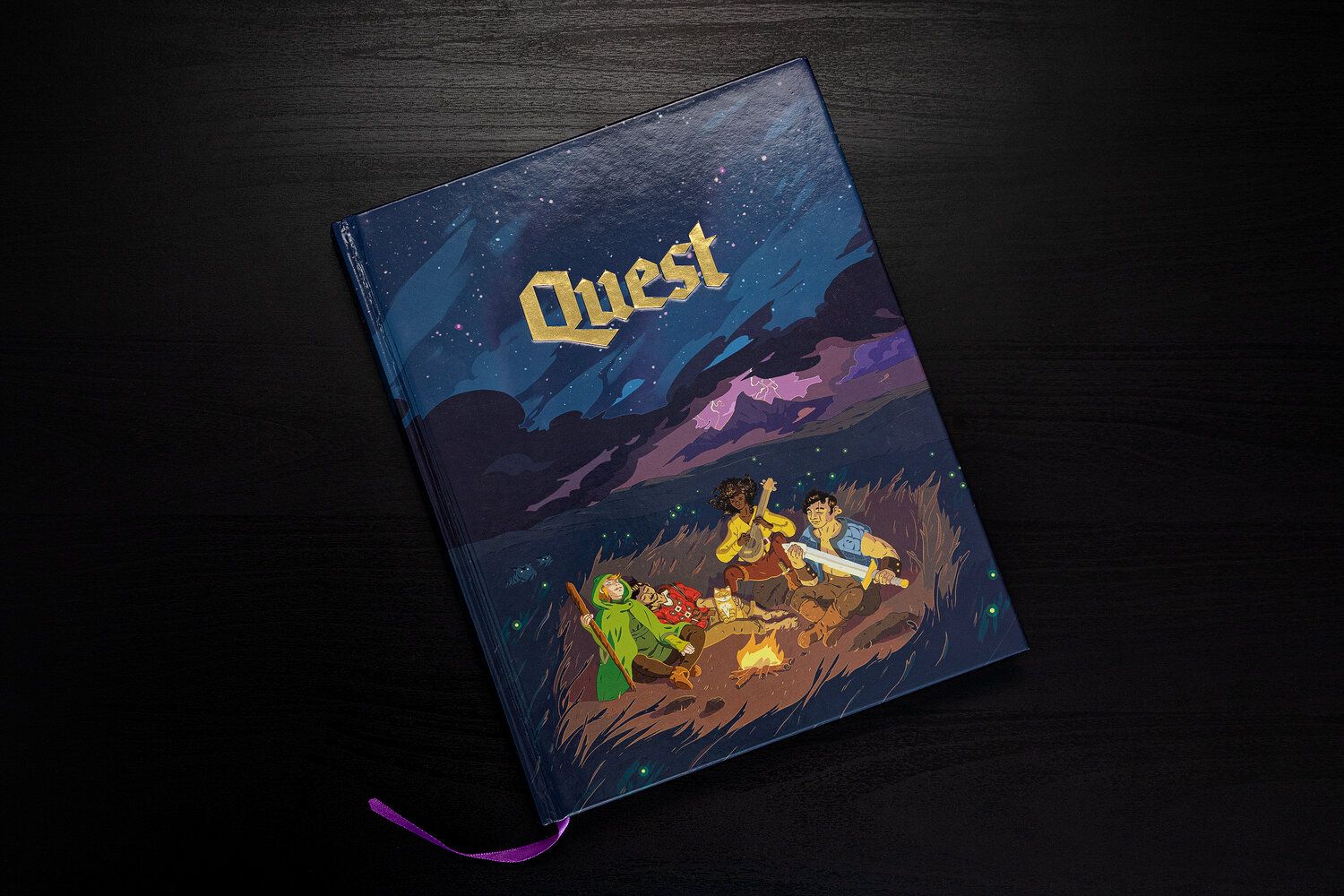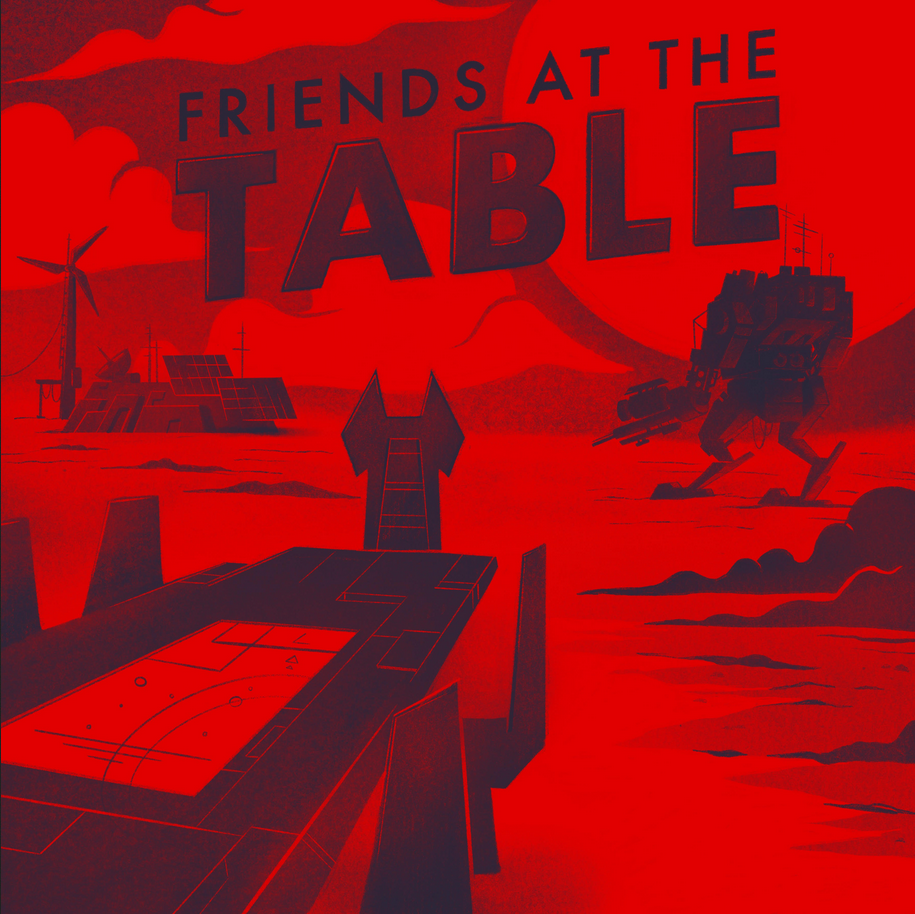The Burden of Worldbuilding
Thinking about OSR, Worldbuilding, and everything in between
March 28, 2020

(From The Black Hack cover)
I’ve been getting into/reading a lot of “Old School Renassiance/Revival” (otherwise known as “OSR”) tabletop RPG stuff and, having recently read through the sourcebook of the newly released Quest RPG, am having a lot of thoughts about tabletop games, settings, and worldbuilding that I thought would be worth writing about.
Implied Settings
Like many thoughts, they began nebulous, a cloud of phrases, quotes, and references, all generally circling the notion of “worldbuilding”. It wasn’t until reading this article though, and specifcially seeing the phrase “implied setting”, that what exactly I was thinking towards started to come into focus.
The context is such:
[OSR TTRPG Game] is a pure rules distillation; significant and skillful work went into excising the implied setting from D&D and making a game document that is much more widely applicable.
The author of the above quote makes a point to draw the line between the presented material (the TTRPG) and what that material itself is referencing (DnD). Because the former is directly referencing the latter, the presented OSR game doesn’t need to restate or rehash what it assumes its reader already knows and understands about DnD. (To the author’s point directly though, the excising of setting to provide a distillation still needs the context of what exactly it is excising from in order for what is presented to be understood as a distillation — the two are still in dialogue together).
This isn’t earth shattering and is more or less the foundational idea of producing a “series” of anything: Every new Star Wars book doesn’t need to tell you who Luke or Vader is, but can count on you, the reader, to bring your knowledge of the story’s universe to the text so that the text itself becomes enriched (if not activated) by your prior understanding.
When it comes to the implied setting of DnD, I think that, like Tolkien fantasy (arguably more or less the same as DnD but with its sillier bits shaved off), it has become a stand-in for the breadth of all fantasy. Other “fantasy” is judged off of its proximity to, or distance from, what is seen as this ground truth. I think some people don’t like this, but I do think it’s a productive framing — it gives us a small signpost or lantern in the dark of the genre’s offerings, acting as a compass for where to go next — i.e. “do you want to get weirder than this?” or “do you want to get more gruesome?” or “do you want less politics?”, etc.
This implied setting is also something that is culturally self-reinforcing — every time you see any sort of mossy grotto or a dungeon or some candlelit prison or a dragon or wizard or whatever, the meaning and rules of this setting are expanded upon. Microworlds spawn off of the main idea, their rules and systems and beliefs setup to directly oppose the hegemonic “world”, but whose meaning comes from the existence of the main genre as their counterpoint (you can’t be subversive if you have nothing to subvert). Game of Thrones is still wholly Game of Thrones but it’s merely a stones throw from Tolkien or DnD if you swap out some constitutient parts.
I say all of this to point out that, personally and culturally, we all know and have a working understanding of the “world” that surrounds the implied setting of DnD. And this goes deep. The most poorly drawn sketch of a dragon and a knight has the capacity to imply and invoke the whole of the “standard” fantasy setting. Even in its crude, you could probably look at the below picture and tell me a story about where this scene is taking place, whose sword is being used, what’s coming out of the dragon’s mouth, what the adventurer’s goals are, etc.

It’s amazing (and I’m thinking here of some of what Matthew Ball talked about regarding marginal affinity), that this setting is so reinforced and its worlds (/capacity to adapt to new worlds) are so fleshed out and that even a crude pass at signaling it is enough to invoke the whole of the setting.
OSR
This was in my mind recently with OSR, as (and this is sort of the whole idea of OSR) OSR modules often don’t do additional work to help provide a world for their tables/rules/etc. (though they’re are obvious exceptions, even in the earlier linked article). They are able to assume player fluency in DnD and skip over the groundwork of reestablishing that world. With OSR though, not only do modules back off of implied setting, but so often they also don’t make any mention of how to actually engage with their contained material — said differently, there is also an implied playstyle that assumes fluency in the system of play itself.
Most OSR things are modules, meant to be slotted alongside some other system that may or may not explain itself, so it’s not crazy that, as a singular document, these modules can quickly become indecipherable. What a module chooses to highlight or draw attention to is lost on an untrained reader because it’s hard to piece apart what is supposed to be an innovation or idea from what is rote from what is a rule vs. improv, etc.
Though these modules all have a place (though some are truly gonzo), it reminds me of the phrase “cargo cult game design” the Zach Barth brings up in his book Zach-Like:
The rest of these pictures (fake Pokemon cards and a homemade Starcraft card game) are early examples of what I call cargo cult game design, which is where amateur game designers copy mechanics from games they like without a design framework or understanding of how mechanics combines to create gameplay and player experiences.
It isn’t a direct parallel, as module makers presumably know the space they are making modules in. But, to newcomers, it can seem like makers are pantomining the idea of building an rpg without actually developing a setting to house their ideas or a framework to play with them in. Modules act as a direct continiumum from an unknown source, talking back to where they came from using language only those in the know understand.
This ambiguity of grounding can also be beautiful. People like Zedeck Siew thrive in this model, producing artifacts for seemingly no system, and whose world is only ever implied but never completely drawn. Creatures of the Near Kingdoms is like a taxonomy of creatures but with stats meant to (or not?) be played. It’s world is barely sketched, meant for the reader to fill in, and for any two readers to draw totally different conclusions about the “who/what/when/where/why” of all of it.
Which brings me back a bit to implied setting and the global conciousness surrouding DnD/Tolkien-esque fantasy — worldbuilding is really hard! Beyond the idea of needing to create a setting that is “interesting”, developing a setting and world that is internally consistent enough that not only a handful but millions of people can all have a shared understanding of it is work. A life’s work even. It makes sense why people basically treat Tolkien/DnD as a “public domain setting,” wrapping up their own games or designs or modules with signifers of this world/setting so that elements an get some resonance for free. It removes the burden on the DM/Creator/Designer/etc. to need to synthesize something with the same resonance on their own.
Quest
I’m thinking a lot about this when I’m reading through the Quest Sourcebook this past week and the question of “who is this for” is circling in my head. The book is meant to be accessible (the first line on their Kickstarter page is “Quest is the roleplaying game for everyone”), but one notable thing about the book is that there is a pretty big divide between who the game is supposed to be accessible for. On one hand it’s very accessible for players (kind of the anti-OSR module) — the summarized rules fit on a single page and the main system for resolution is standard D20 rolls. But for so much of the books text, it tosses any sort of need for resolution of conflicting actions, management, and worldbuilding at the DM running the game. Which, in my experience, is the antithesis of “accessible”.

“Accessible” also doesn’t obviously mean “easy,” but I’m really focused on the phrase “the roleplaying game for everyone” there and wondering what roleplaying games aren’t for everyone. Or how a roleplaying game can be not for someone. In a way, what I talked about above with regards to OSR modules stands out — these are specialized modules for a subset of people who generally know how to use the impled playstyle of DnD. Quest definitely doesn’t have that (it is self contained), but at the same time it’s effectively teaching you how to do tabletop roleplay, just, to quote a friend “with better onboarding”.
It’s actually like OSR in that way (presumably being the roleplaying game not for everyone): rules are sparse and the DM is relied upon to give players freedom to explore/experiement (the word “sandbox” usually gets tossed in here). However, Quest, almost defiantly so, makes a point to not invoke the implied setting of DnD. Even more like an OSR module (again, the not for everyone option), it’s a system of rules in search of a setting.
It gives the DM tools to summon their own world with adventure hooks and such, but the game seems to want to have its cake and eat it too — references are made to DnD-ish things but then also non-DnD things and things that very anti-DnD but then also it’s supposed to be your own creation but then also not really because items have narrative-y descriptions that imply some other world.
And given how hard it is to create your own compelling setting for players (again, a life’s work), I’m just thinking of the DM that picks this up this “game for everyone” and tries to synthesize all of this and just kind of ends up using a DnD-ish setting anyways.
Reading the book in general, it’s still very much a TTRPG, and, if the DM already has to do all the work and the players are effectively going to be playing in a DnD world anyways, why play this over something like DnD? Especially if the DM is learning all of the rules and is teaching their players, you could pretty easily learn all of DnD and then play a subset of those rules with your players and you’d effectively be playing Quest and have a fleshed out setting you could rely on. This is also not crazy — no TTRPG group I’ve ever known has ever played DnD to a tee with all of its rules. The 5E rules even state up front in the players guide that the rules are more of a suggestion than fact.
I don’t meant to sound disparaging of Quest as I think the book is beautiful and the “play” of the thing seems nice, but for some reason it has come to me at a time when a lot of these intersecting thoughts are happening and feels like a battleground of ideas, opinions, methodologies, theories, etc. It’s like OSR/5E/PbtA, all wrapped up in one and not sure what it actually is, and seems to say more about those other things than it says about itself.
Friends at the Table
I’m also thinking about this because I’ve been listening to the latest season (Partizan) of the Friends at the Table podcast. For those who don’t know, Friends at the Table is a TTRPG podcast focused around “critical worldbuilding and smart characterization,” which usually boils down to the fact that they make up their own fully fleshed out, non-DnD settings and characters. I’m thinking about this podcast because, unlike Quest or lots of OSR stuff, FatT actually does craft its own settings for their stories and games to talk place in. And through their exposure of that process to their listeners, it’s easy to see why so many people don’t do this.

Imagine if someone had to explain Tolkien fantasy to you from the ground up, assuming you knew nothing. This is not a small endeavor — in fact it may easily take days, months, years of nonstop communication to explain every single detail that exists. It’s easy to forget that we have been learning its world for a lifetime. That every marginally related story, book, movie, game, etc. increases and reinforces our understanding of its mythos and folds itself into our understanding.
To create something wholly new then should take at least this much time, at least if we all want to have a shared understanding of the world and what’s in/out (i.e. we all agree that dragons are in DnD, we all also likely agree that Spaceships aren’t in DnD).
Friends at the Table spends no less than 15 dense hours of podcasting (The Road to Partizan Series) sketching out a world to set their latest game inside of, and even then it doesn’t feel like it’s enough or scratch the surface. It’s enough to be established, but even then barely enough to get started. Not only this but as the players play, it’s not like the DM’s work is done or on autopilot. They, as actors in the created world, are also changing it’s meaning and history and teasing out its parts and limits and histories, etc, leaving behind them a trail of more in the world that could itself be its own seperate podcast. Small asides and glances can imply years of story, never to be discovered.
I don’t think everything should do what Friends does, nor do I think that people shouldn’t pull from preexisitng worlds (Star Wars, DnD, Tolkien, whaever). What I’m getting at is the way that both implied settings and implied playstyles work their way into these games and our media that it’s easy to forget they are there or that it’s actually happening. OSR (likely the most aware) conciously leverages implied setting and implied playstyle to try something new (it is OS[R]ennassiance). Quest posits a new “new” playstyle, but “works” because of an implied setting (and honestly maybe even some implied playstyle), but won’t own up to that and becomes confusing product as a result. Friends at the Table actually creates a new setting, but risks alienation for all but the most bought-in listeners (of which there are a lot, to be fair) due to the lack of easy touchpoints that may have been reinforced since birth.
It’s this mixing of settings and themes and mechanics that make all of this intersting to look at now. Above I mentioned Quest as a sort of “battleground” for ideas — notably though, this battle is quiet. These things all exist peacefully next to each other. I’ve only just begun dipping my toes in, but the water seems calm. It’s great the DnD (old or new) isn’t the only thing in town and that people are iterating around its core ideas or discarding it entirely or pilfering it for something new. Right now it feels like people are exploring. Figuring out what’s next or what way to move forward, and, thankfully, all finding meaning in taking different paths.
Thanks for reading!
Errata
After writing this I ended up going through more of Cannibal Halfling’s archives and found the post The Trouble with Worldbuilding that touches on some similar ideas I bring up here! From the post:
I don’t think it’s bad to want to run games inspired by or even set in your favorite books, movies, and video games. I wouldn’t call it worldbuilding, though. Adapting someone else’s setting is a different (and just as challenging) task from writing your own, and if your “original” setting ends up being (to cite an all too common example) “like Tolkien but”, it’s probably not interesting, certainly not more interesting than a good adaptation. And while you can be proud of your not interesting setting, I could make a similar one just using the core 5e books in a weekend, so what exactly are you doing?
I also read Pretendo.games’s post Unwritten Rules of Play that sketched an idea of what things are worth spelling out for new DnD/OSR players. I’m not adovcating for modules to all need an introduction to roleplaying games, but sketching an idea of how they “fit” would be nice. From the piece:
I do think there are a lot of assumptions built into GM’d games, especially those with “old school” D&Dish sensibilities, that are worth presenting as best practices for play, sometimes even as part of the rules text itself.
Published on March 28, 2020.